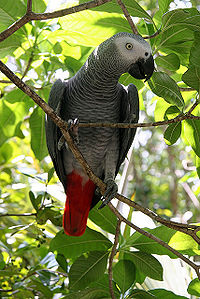African Gray Parrot
 From Conservapedia
From Conservapedia | African gray parrot | |
|---|---|

| |
| Scientific classification | |
| Kingdom Information | |
| Domain | Eukaryota |
| Kingdom | Animalia |
| Subkingdom | Bilateria |
| Branch | Deuterostomia |
| Phylum Information | |
| Phylum | Chordata |
| Sub-phylum | Vertebrata |
| Infraphylum | Gnathostomata |
| Class Information | |
| Superclass | Tetrapoda |
| Class | Aves |
| Sub-class | Neornithes |
| Infra-class | Neoaves |
| Order Information | |
| Superorder | Psittacimorphae |
| Order | Psittaciformes |
| Family Information | |
| Family | Psittacidae |
| Sub-family | Psittacinae |
| Tribe Information | |
| Tribe | Psittacini |
| Genus Information | |
| Genus | Psittacus |
| Species Information | |
| Species | P. erithacus |
| Subspecies | P. erithacus |
| Population statistics | |
| Population | 560,000 (2018 est.) |
| Conservation status | Endangered[1] |
The African Gray Parrot (Psittacus erithacus) is a species of parrot of the family Psittacidae, and native to Africa. One of the most intelligent species of parrots, it is acclaimed for the imitations it can make on almost any sound; the acclaims however, came at a price: the bird has recently been classified as endangered due to the pet trade.
Description[edit]
The African gray parrot is medium-sized, with a length of 13 inches, a wingspan of 18-20 inches, and a body weight of 0.9–1.16 pounds. As the name implies, it is gray in color, with the coloration slightly darker above versus the chest and belly, and mottled throughout with a slight line of white at each feather tip. The exception is the face, which has a large white patch around the eyes, and the red tail. The feet are a dark-gray, the bill is blackish-gray, and the eyes are yellow.
Subspecies[edit]
- Psittacus erithacus erithacus; Ivory Coast east to Kenya, Tanzania, Príncipe, São Tomé and Bioko
- Psittacus erithacus princeps; Príncipe Island
A third subspecies, P. e. timneh was recently classified as a species in its own right, due to genetic research, as well as physical differences in size and coloration.
Diet[edit]
African gray parrots prefer fruits, nuts, seeds, flowers and buds; they are more of a generalist feeder than a specialist. Plants include the oil palm; tamarind; papaya; bushwillow; bananas; millet; maize and other agro-crops; almonds.
Threats[edit]
This species is among the most popular cage birds; its intelligence and ability as a mimic cannot be matched by any other bird, and they can easily top 200 individual words, with one example having a vocabulary of over 1,000 words[2]. This human desire to have such a bird in the home has made inroads in the population, to the point where it is now one of the most illegally trafficked birds in the world[3]. Currently, the global population stands at 560,000 to 12.7 million birds, both wild and captive, yet wild birds are easily caught. The Democratic Republic of the Congo witnesses 18,000 birds trafficked yearly. Ghana has lost over 90% of its gray parrot population[4], and of the birds that do survive being caught, many die enroute to markets[5]. In 2016 it was placed in the CITES Appendix I listing[6][7][8], essentially banning all trade except captive-bred birds.
Natural threats include birds of prey, such as hawks, eagles, and the palm nut vulture. Snakes and monkeys have also been known to prey upon chicks in the nest.
References[edit]
- ↑ https://www.iucnredlist.org/species/22724813/129879439
- ↑ http://animal-world.com/encyclo/birds/greys/AfricanGreys.htm
- ↑ https://news.nationalgeographic.com/2018/05/why-the-world_s-most-popular-parrot-could-become-the-rarest/
- ↑ https://www.birdlife.org/africa/news/ghana’s-grey-parrot-population-may-soon-cease-exist
- ↑ https://www.nationalgeographic.com/magazine/2018/06/photo-ark-parrots/
- ↑ https://wwf.panda.org/?279870/African-Grey-Parrots
- ↑ https://www.iucnredlist.org/species/22724813/129879439#conservation-actions
- ↑ https://af.reuters.com/article/idAFKCN1220GR
Categories: [Parrots] [African Tropical Parrots]
↧ Download as ZWI file | Last modified: 03/06/2023 00:06:20 | 2 views
☰ Source: https://www.conservapedia.com/African_gray_parrot | License: CC BY-SA 3.0
 ZWI signed:
ZWI signed: KSF
KSF